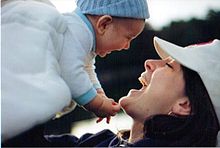Maternal bond



A maternal bond is the
Both physical and emotional factors influence the mother-child bonding process. In separation anxiety disorder a child becomes fearful and nervous when away from a loved one, usually a parent or other caregiver. New mothers do not always experience instant love toward their child. Instead, the bond can strengthen over time, or fail to develop. Bonds can take hours, days, weeks, or months to develop.[1]
Pregnancy
The maternal bond between a
The developing fetus has some awareness of the mother's heartbeat and voice and can respond to touch or movement and could hear sounds around the surroundings. By the seventh month of pregnancy, two-thirds of women report a strong maternal bond with their unborn child.[1]
Some mothers who
Childbirth and post pregnancy
Childbirth is an experience that can strengthen the mother and child bond. Factors such as a traumatic birth, the mother's childhood, medical stress, lack of support and the influence of a spouse or partner/family or socioeconomic factors like poverty can weaken the bond.
Post pregnancy can be seen as a time for emotional bonding for children even if they were born prematurely, they can still bond by cuddling and hugging or even by touching next to the incubators and playing with children can help with bonding especially of it was skin to skin like share bonding/touch even if it was from the NICU.[3]
Emotional bonding theory first appeared in the mid-1970s in the studies,[4] and by the 1980s had become an accepted phenomenon. Soon, the process became analyzed and scrutinized to the point of creating another term – poor bonding.
Oxytocin
Production of
Breastfeeding is also strongly believed to foster the bond, via touch, response and mutual gazing as it stimulates the experience with the baby gazing up and down the mother and drinking from the mother's nipples.[8]
Maternal separation anxiety
Beginning at 9–10 months of age when infants begin to crawl and then when they begin to walk around 12 months of age, they begin to develop capacities to physically explore the world away from their mother.[9] These capacities bring with them separation anxiety as the infant becomes more vulnerable away from mother. This newly acquired motor development parallels infants' intellectual curiosity, and cognitive and language development as they begin to point and name, and jointly attend with mothers to their environment beginning by 9–10 months. Most parents welcome these explorations and this increased independence. However, in the context of maternal depression, trauma or disturbed bonding in her own early life, some mothers have significant difficulty in tolerating the exploration and-or the infant's anxiety.[10]
This separation anxiety increases when infants and toddlers feel threatened or socially reference their mothers for reassurance. The research claimed out that mothers, for example, with histories of violence exposure and
Child separation anxiety
Inevitably, children who have rarely been separated from their mother become anxious when separated for extended periods. This is most commonly experienced when starting to attend school. Separation anxiety can cause children to be unable to be open to new experiences such as attending school regularly. There is a relationship between child separation anxiety and school refusal.[12]
Attachment happens after childbirth and does not form and is likely more fluid as you go further in later in life, this anxiety can reoccur if mothers have to leave their family unit to work. In both cases, the child's anxiety (and that of the parents) can be reduced by priming, i.e. preparing the child for the experience before its occurrence and by creating and maintaining dialogue and connection between the absent parent and child during the separation. Many children may experience such anxiety in various forms.[13] Child separation anxiety may be a learned behaviour which can occur over time initiating from innate fears of separation or trauma.[14]
See also
- Postpartum confinement
- Human bonding
- Paternal bond
- Cinderella effect
- Mother's boy
- Babywearing, co-sleeping
- Breastfeeding and mental health
Footnotes
- ^ PMID 10750284.
- ^ a b [And that has been proven with a statistic of only 20% of motehrs felt that they have an actual connection with a child, after hours of deliveries. (steinfield) https://www.webmd.com/parenting/baby/forming-a-bond-with-your-baby-why-it-isnt-always-immediate http://healthypeople.gov/2020/topicsobjectives2020/overview.aspx?topicid=13 "Family Planning – Healthy People 2020"]. HealthyPeople.gov. Retrieved 2011-08-18.
{{cite web}}: Check|url=value (help) This reference cites:- Logan C, Holcombe E, Manlove J, et al. (May 2007). The consequences of unintended childbearing: A white paper (PDF) (Report). Washington: Child Trends. Archived from the original (PDF) on July 2, 2010. Retrieved March 3, 2009.
- Cheng D, Schwarz EB, Douglas E, Horon I (March 2009). "Unintended pregnancy and associated maternal preconception, prenatal and postpartum behaviors". Contraception. 79 (3): 194–198. PMID 19185672.
- Kost K, Landry DJ, Darroch JE (Mar–Apr 1998). "Predicting maternal behaviors during pregnancy: does intention status matter?". Family Planning Perspectives. 30 (2): 79–88. PMID 9561873.
- D'Angelo DV, Gilbert BC, Rochat RW, Santelli JS, Herold JM (Sep–Oct 2004). "Differences between mistimed and unwanted pregnancies among women who have live births". Perspectives on Sexual and Reproductive Health. 36 (5): 192–197. PMID 15519961.
- ^ "Bonding with sick or premature babies in the NICU".
- PMID 21301556.
- ISBN 978-0-7637-8345-7.
- ISBN 978-1-139-78900-4.
- ISBN 9783902902122.
- ^ Else-Quest NM, Hyde JS, Clark R (2003-10-01). "Breastfeeding, bonding, and the mother-infant relationship". Merrill-Palmer Quarterly. Retrieved 2008-03-13.
- ISBN 978-0-631-21627-8.
- PMID 23756225.
- PMID 26074844.
- S2CID 252536285.
- PMID 25980507.
- ISSN 0762-7491.
